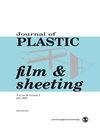Coating of micropolar fluid during non-isothermal reverse roll coating phenomena
IF 1.5
4区 材料科学
Q3 MATERIALS SCIENCE, COATINGS & FILMS
引用次数: 0
Abstract
Reverse roll coating is a high-speed coating process used in many applications. The single largest application for reverse roll coating is applying architectural paint to coils of sheet metal; however, in the converting industry reverse roll coating is used for some thermal coatings, adhesives, color laser paper receivers, wax coatings, magnetic coatings, vinyl dispersions for wallcovering, some specialty light sensitive applications, and many specialty products that require a high precision application process. This work presents a mathematical model for the steady flow of non-isothermal, incompressible, micropolar fluid in the metering nip of a reverse roll coater with velocity slip applied at both roll’s surfaces. Lubrication approximation theory (LAT) is utilized to reduce the complexity of the non-dimensional equations. Exact solutions for pressure gradient, velocity, and temperature are achieved. At the same time, numerical techniques (Simpson’s 3/8 rule with Newton Raphson method) are used to compute the pressure distribution, coating thickness, flow rate, and separation points. Effects of coupling number, slip parameter, microrotation, and velocity ratio on velocity, pressure, temperature, and pressure gradient are presented in graphs. It is observed from the current analysis that the intrinsic rotations of the fluid particles prove to be the controlling parameter of the pressure gradient, which significantly varies the coating thickness. Also, as a result of velocity slip, the flow rate declines and the coating thickness reduces as the fluid moves faster along the boundary walls.在非等温反向辊涂现象中涂覆微极性流体
反向辊涂是一种高速涂覆工艺,应用广泛。反向辊涂的最大应用是将建筑涂料涂覆到金属板卷材上;然而,在加工业中,反向辊涂还用于某些热涂料、粘合剂、彩色激光纸接收器、蜡涂料、磁性涂料、用于墙纸的乙烯基分散体、某些特殊光敏应用以及许多需要高精度涂覆工艺的特殊产品。本研究提出了一个数学模型,用于非等温、不可压缩、微极性流体在反向辊涂机计量压区的稳定流动,两辊表面均有速度滑移。利用润滑近似理论(LAT)降低了非尺寸方程的复杂性。实现了压力梯度、速度和温度的精确求解。同时,利用数值技术(Simpson's 3/8 规则与 Newton Raphson 方法)计算压力分布、涂层厚度、流速和分离点。耦合数、滑移参数、微气浮和速度比对速度、压力、温度和压力梯度的影响用图表表示。从目前的分析中可以看出,流体颗粒的固有旋转被证明是压力梯度的控制参数,会显著改变涂层厚度。此外,由于速度滑移,当流体沿边界壁快速移动时,流速下降,涂层厚度减小。
本文章由计算机程序翻译,如有差异,请以英文原文为准。
求助全文
约1分钟内获得全文
求助全文
来源期刊

Journal of Plastic Film & Sheeting
工程技术-材料科学:膜
CiteScore
6.00
自引率
16.10%
发文量
33
审稿时长
>12 weeks
期刊介绍:
The Journal of Plastic Film and Sheeting improves communication concerning plastic film and sheeting with major emphasis on the propogation of knowledge which will serve to advance the science and technology of these products and thus better serve industry and the ultimate consumer. The journal reports on the wide variety of advances that are rapidly taking place in the technology of plastic film and sheeting. This journal is a member of the Committee on Publication Ethics (COPE).
 求助内容:
求助内容: 应助结果提醒方式:
应助结果提醒方式:


